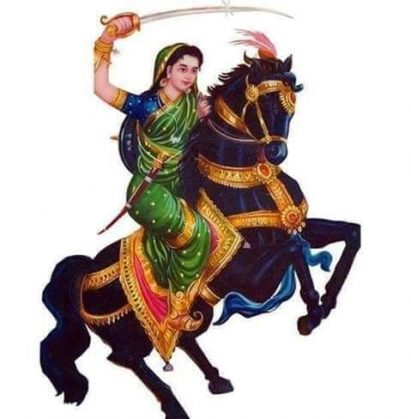India has had many iconic queens in its history who have left their mark on Indian society. This article discusses ten of the most remarkable queens, each with their unique story and legacy. Among these queens is Rani Lakshmibai of Jhansi, a symbol of bravery and courage who fought against the British during the Indian Rebellion of 1857, and Ahilyabai Holkar, a military strategist who expanded her kingdom’s borders and encouraged trade and commerce. Other queens include Razia Sultan, the first female Muslim ruler of India, Chand Bibi, a warrior who protected her kingdom from invading forces, and Maharani Gayatri Devi, a fashion icon and politician who fought for India’s independence. These queens left a lasting legacy of empowerment, resilience, and social, cultural, and political contributions to India.
The stories of India’s ten most iconic queens serve as a testament to the indomitable spirit and legacy of women throughout Indian history. Despite facing numerous obstacles and opposition, these queens fought for their kingdoms, their people, and their rights, leaving behind a rich legacy of social, cultural, and political contributions to India. Their stories continue to inspire and empower women to this day and serve as a reminder of the significant role that women have played in shaping India’s history and culture.
1. Rani Lakshmibai of Jhansi
Rani Lakshmibai of Jhansi, also known as the “Warrior Queen,” was a prominent figure in Indian history and a symbol of bravery and courage. She was born in Varanasi in 1828 and was married to Raja Gangadhar Rao, the Maharaja of Jhansi, at 14. After her husband’s death, she was denied the right to adopt an heir and was forced to defend Jhansi from the British during the Indian Rebellion of 1857. She is a skilled military strategist who led her army in battles against the British in 1857 and was known for her bravery and determination. Her reign as Queen of Jhansi lasted for only six months, from August 1857 to January 1858, but she left an indelible mark on Indian history. She introduced several key reforms, including the abolition of the practice of sati and the introduction of laws to protect women’s rights. She was also a staunch advocate for the education of girls and women and established several schools in Jhansi. Rani Lakshmibai died in battle in Gwalior in 1858, at the age of 29. Her death was a significant loss to the Indian independence movement, and she remains a revered figure in Indian history.

2. Ahilyabai Holkar
Ahilyabai Holkar was a remarkable queen who ruled the Maratha kingdom in India from 1767 to 1795 for 30 years successfully. Born in 1725 in the village of Chaundi in Maharashtra, she was married to Khande Rao Holkar at the age of 8 and became queen after his death. Ahilyabai Holkar was known for her administrative and military skills, and she personally led several military campaigns to expand her kingdom’s borders. She fought against the Mughals, the Nizam of Hyderabad, and the British. During her reign, she established law and order, built temples, and encouraged trade and commerce. Her kingdom spanned a vast area that included parts of present-day Madhya Pradesh, Maharashtra, and Rajasthan. Ahilyabai Holkar was a patron of art and literature, and she was known for her generosity towards the poor and the needy. She died in 1795 at the age of 70 and is remembered as one of India’s greatest rulers.

3. Razia Sultan
Razia Sultan was a remarkable figure in medieval Indian history who became the first and only female Muslim ruler of Delhi. She ascended to the throne in 1236 AD after the death of her father, Sultan Iltutmish, who chose her over his other sons as his successor. During her brief reign of four years, Razia Sultan fought several battles and expanded her empire to include Delhi, Sindh, Punjab, and parts of Rajasthan. She was known for her bravery, military acumen, and administrative skills, and was popular among her subjects for her just and fair rule. Some of the key reforms she introduced included the abolition of the Jizya tax on non-Muslims and the appointment of qualified officials regardless of their religion. However, her reign was marked by opposition from conservative elements in her court and family, who resented her gender and questioned her authority. Razia Sultan died in 1240 AD, reportedly in a battle against her half-brother who had rebelled against her rule. Her legacy as a trailblazer for women’s rights and a capable ruler has endured through the centuries.

4. Sultana Chand Bibi
Chand Bibi was a remarkable queen and warrior of the 16th century, who rose to power in the Deccan Sultanate during a time of political instability. She became the queen of Bijapur after her husband’s death and effectively ruled for over a decade. She fought several battles to protect her kingdom from invading forces, including the Portuguese, who posed a significant threat to the region. During her reign, she implemented key reforms that improved the lives of her subjects, such as lowering taxes and promoting agriculture. Chand Bibi was known for her tactical genius, bravery, and strong leadership, which earned her the respect and admiration of her people. Unfortunately, her reign was cut short when she was assassinated in 1599 while defending her kingdom against the combined forces of Bijapur and Golconda. Despite her untimely death, her legacy lives on as a symbol of women’s empowerment and resilience in Indian history.

5. Maharani Gayatri Devi
Maharani Gayatri Devi was an Indian royal and politician who was known for her beauty, elegance, and intellect. She was born on May 23, 1919, in London and became the third queen of the princely state of Jaipur at the age of 21 after marrying Maharaja Sawai Man Singh II. During her reign, she fought for India’s independence, led numerous social and cultural initiatives, and implemented many reforms, including the promotion of women’s education and the preservation of Jaipur’s cultural heritage. She also served as a Member of Parliament and was considered one of the most glamorous women of her time. Her unique personality and style made her a fashion icon, and she was featured in several international magazines. Maharani Gayatri Devi died on July 29, 2009, at the age of 90, in Jaipur, Rajasthan, leaving behind a rich legacy of social, cultural, and political contributions to India.

6. Rani Durgavati
Rani Durgavati was a brave warrior and queen of the Gond Kingdom in central India during the 16th century. She was born in the family of Chandel Rajput and married Dalpat Shah, the ruler of the Gond Kingdom, becoming queen in 1542. She fought several battles against the Mughal Empire, including the famous Battle of Narrai in which she defeated the Mughal army led by Asaf Khan. She ruled for fifteen years and her kingdom extended over much of present-day Madhya Pradesh and parts of Chhattisgarh and Maharashtra. Rani Durgavati implemented several key reforms, including the construction of roads and wells and the establishment of schools and hospitals. She was known for her bravery, wisdom, and justice, and was respected by her subjects. Rani Durgavati died in 1564 while fighting against the Mughal army led by Akbar’s general Adam Khan in a battle at a place called Chauragarh. She is remembered as a symbol of courage and sacrifice, and her legacy continues to inspire generations.

7. Queen Karnavati
Rani Karnavati was a brave and charismatic queen of the Indian kingdom of Mewar in the 16th century. She became queen after her husband’s death and successfully defended her kingdom against numerous attacks from neighboring rulers, including the Sultan of Gujarat. Rani Karnavati was known for her military prowess, and she fought fiercely to maintain her kingdom’s independence. Under her rule, Mewar expanded its territory and controlled several regions in Rajasthan. Rani Karnavati also implemented several important reforms in the areas of taxation, education, and social welfare. She was a compassionate ruler who cared deeply for her subjects and worked tirelessly to improve their lives. Sadly, Rani Karnavati’s reign was cut short when she died while defending her kingdom against the invading Mughal armies in 1537. Her bravery and sacrifice have made her a legendary figure in Indian history, and she remains a symbol of courage and resilience to this day.

8. Kittur Rani Chennamma
Rani Chennamma, also known as Kittur Chennamma, was an Indian queen and warrior who fought against the British East India Company’s annexation of her kingdom in the 19th century. She was born in 1778 and became the queen of the Kittur region in Karnataka, India, after her husband’s death. She led the resistance against the British in the First War of Independence, which took place in 1824. Rani Chennamma was a skilled strategist who successfully defended her kingdom in several battles, including the Siege of Kittur. She ruled Kittur for about 33 years and controlled several other territories in the region. Rani Chennamma was known for her progressive reforms, including the abolition of the practice of Sati and the establishment of a market for silk production. She was a symbol of resistance against British imperialism and remains a celebrated figure in Indian history. Rani Chennamma died in 1829 while imprisoned by the British in Bailhongal Fort, and her legacy has continued to inspire generations of Indians to fight for independence and freedom. Her heroic struggles and sacrifices for the cause of her people have made her an icon of courage and resistance, and she is remembered as a true warrior queen.

9. Maharani Jijabai
Maharani Jijabai, also known as Rajmata Jijabai, was a prominent queen and mother of the legendary Maratha king, Shivaji Maharaj. She was born in a prominent family in Sindkhed in 1598 and married Shahaji Bhosale, a general in the Nizamshahi dynasty. After her husband’s death, she continued to raise her son Shivaji and played a key role in his education and upbringing. Jijabai was a skilled warrior and strategist, and she fought alongside her son in several battles against the Mughals and other enemies. She ruled for over three decades, from 1645 to 1674, and her reign extended over large parts of Maharashtra. Jijabai was known for her administrative and social reforms, such as the construction of water reservoirs, temples, and markets, and the promotion of agriculture and trade. She also encouraged the education of women and girls and supported various cultural and religious activities.She passed away in 1674 at the age of 76, just a few months after her son Shivaji’s coronation as the Chhatrapati of the Maratha kingdom. Her legacy lives on as a symbol of strength, courage, and devotion to duty.

10. Rani Rudramadevi
Rani Rudramadevi was a legendary queen of the Kakatiya dynasty who ruled the kingdom of Warangal in present-day Telangana, India, from 1262 to 1289 CE. She was born to King Ganapathi Deva and Queen Rudrama Devi and was brought up as a boy to avoid a political crisis. After her father’s death, she ascended to the throne and became the first queen of the Kakatiya dynasty. She was a skilled warrior and fought several battles against the Yadava dynasty, the Cholas, and the Pandyas. Under her rule, the kingdom of Warangal expanded to include several neighboring territories, including the Raichur and Mudgal regions. Rani Rudramadevi was known for her administrative skills and introduced several reforms in the fields of irrigation, agriculture, and education. She also patronized art and literature and encouraged the growth of the Telugu language. She died in 1289 CE while fighting against the invading forces of the Yadava king, Mahadeva. Rani Rudramadevi is remembered as a brave and compassionate queen who brought peace and prosperity to her kingdom.



















